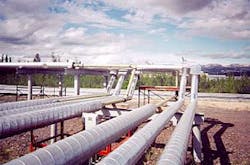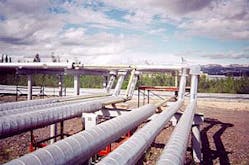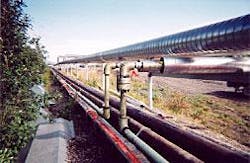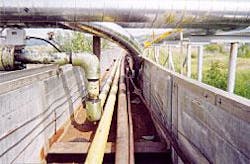Fiberglass flowlines proved effective for replacing some corroded flowlines in the Norman Wells oil field in Canada’s Northwest Territories. Imperial Oil Ltd. operates the field, which is near the Arctic Circle.
Most flowlines at Norman Wells are carbon steel, but Imperial Oil has installed fiberglass pipe in appropriate situations on a case-by-case basis after considering such factors as service and installation conditions, fluid corrosiveness, number of joints needed, service pressure, longevity needed, operating costs, and life-cycle costs.
The fiberglass-reinforced epoxy pipe is a composite material that resists internal and external corrosion. Figs. 1 shows some of the field’s flowlines.
Norman Wells area
The town of Norman Wells, population 800, sits on the north bank of the Mackenzie River, about 425 miles northwest of Yellowknife and 75 miles south of the Arctic Circle. Edmonton, is about a 1,370-mile drive to the south of Norman Wells.
The Norman Wells area has a discontinuous permafrost, and muddy conditions often close roads during the summer. The only transportation paths during that time are either air or water routes.
The oil field is in the Mackenzie River, which is the longest river in Canada, covering a distance of more than 1,100 miles. The river begins at Great Slave Lake in the Northwest Territories and flows north into the Arctic Ocean. Its 1.12-million sq mile watershed drains one-fifth of Canada.
Because of its role in the ecosystem, the MacKenzie River is a sensitive environment. In response to this concern, Imperial Oil has a zero-tolerance policy regarding flowline failures.
Corrosion problem
In recent years, changing operating conditions have accelerated flowline corrosion at Norman Wells. The initial buried carbon-steel lines in the field lasted about 12 years. These lines primarily failed due to external corrosion caused by ground water.
Imperial Oil replaced these lines with aboveground, carbon-steel lines with a 50% thicker wall. But some of these new lines failed after only 3 years. The company attributed the faster failure rates to internal pitting caused by higher water content in the flow and lower producing rates from the wells that allowed water pockets to accumulate in low spots in the flowlines. Oxygen in the water also contributed to the corrosion.
Imperial Oil uses cathodic protection on the carbon-steel lines but found it ineffective in permafrost. And even with an efficient pigging system for monitoring flowline integrity, it felt that it could not have zero failures entirely with carbon-steel pipe and therefore decided to install fiberglass pipe in appropriate locations.
The company has had a multimillion-dollar pipe replacement program underway at Norman Wells since 2000, and in the past 3 years, it has replaced about 10 miles of flowlines of which about half were fiberglass lines.
Fiberglass pipe
Imperial Oil started studying the installation of fiberglass pipe at Norman Wells in about 1998 or 1999 but had apprehensions because of poor previous experiences with fiberglass. Because the area is subarctic, the company was concerned about whether the material was appropriate for the cold climate; therefore, it continued to replace corroded flowlines with carbon steel, but it also started researching previous problems with fiberglass pipe.
The research determined that the problems with fiberglass pipe mainly were associated with construction activities such as pipe installation or improper quality control of the threaded connections. The problems were not caused by installation of fiberglass pipe in a high pressure or high-temperature environment. The main causes were incorrect installation in applications with ground vibration and attempts to save money by employment of installation companies inexperienced with fiberglass pipe and its connections.
Imperial Oil installed one fiberglass-line pilot to observe the effects of cold winter temperatures on the line. To date, the line has operated without problems.
It obtained its fiberglass pipe from Western Fiberglass Sales Ltd., Red Deer, Alta., and selected for use the Star 2000 pipe manufactured by Fiber Glass Systems, San Antonio.
The pressure and temperature rating of this pipe is greater than needed, but Imperial Oil selected it so that the pipe would withstand more wear.
The fiberglass pipe cost more than the carbon-steel pipe that it replaced, but Imperial Oil found that the lower installation cost of the fiberglass pipe brought the difference in total cost to zero. Also, installation of the fiberglass pipe eliminated the need for chemical inhibitors, cathodic protection, and pipeline pigging and logging.
Norman Wells has carbon-steel flowlines with welded connections, whereas the fiberglass joints have treaded connections. With fiberglass pipe, one or two workers can pick up pipe joints and easily handle and thread the joints together. Fiberglass provides a quick way to put together a flowline system.
Western Fiberglass estimates that the installation cost of fiberglass pipe can be 25-40% less than for laying conventional steel pipe. The fiberglass pipe eliminates the need for large equipment to lift the pipe on racks. Also the fiberglass has treaded connections, whereas the steel pipe with welded connections requires x-ray inspection of the welds, soap tests for leaks, and the running of sizing pigs.
The company estimates that a six-man crew can lay 3,000 ft of fiberglass pipe in 2 hr compared with the 4-5 hr needed for steel pipe. Installation of steel pipe also requires three welders and a boom crane, so that in this case, the pipe gang would have 10-12 men. Shipping the pipe is also less for fiberglass. Western Fiberglass estimates that a semi truck can haul about 18,000 ft of 3-in. fiberglass pipe compared with 5,000-6,000 ft of the heavier steel pipe.
One area that Imperial Oil spent engineering time was on the design of the fiberglass-pipe structural supports in a permafrost region. With the frost thickness varying during the year, the pipe supports heave out of or sink into the soil, thus increasing the stress on the pipe.
Pipe insulation is also a factor in pipe-support design. Because insulation tends to stiffen the pipe, an insulated flowline can allow longer distances between pipe supports than for traditional fiberglass. Imperial Oil used the same support spacing as for steel.
Recommended support spacing for fiberglass is only 10-12 ft, but the spacing can be 30 ft with the added stiffness provided by the insulation. This larger spacing reduces the costs because installing piles in the ground can be expensive. Many flowlines have more vertical pipe than horizontal pipe. In places at Norman Wells, the bedrock is shallow but one must also take into consideration the permafrost.
Steel price increase
Western Fiberglass says that because of recent increases in bare-steel prices, fiberglass pipe now costs about the same as steel pipe and internally coated steel pipe costs more than fiberglass pipe. This is a change from the time when the Canadian dollar to US dollar exchange rate was about 58% and steel prices were lower. At that time, fiberglass pipe cost about 8% higher than internally coated steel pipe. Steel-pipe prices have gone up about 88% in the last year.
Western Fiberglass also says that steel is hard to obtain in Canada. Canada has many steel manufacturing plants, but it takes time to fill orders as steel prices continue to increase. Right now, Western Fiberglass believes it can obtain fiberglass products quicker than steel products. It sees this as a major factor for oil fields installing more fiberglass pipe.
Fiberglass in Canada
Although fiberglass pipe is new at Norman Wells, it is not new to Canada. Its first use was in southeastern Saskatchewan where some fiberglass lines have been in the ground for more than 35 years. In Alberta, sales of fiberglass increased after installation of the pipe at the Swan Hills Judy Creek field north of Calgary.
Imperial Oil used to own that field and Western Fiberglass started running fiberglass pipe in the field in 1993. In some cases, fiberglass replaced steel lines that had been in the ground for only 6-8 months. The field has hot 185° F. flowline operating temperatures.
The field’s new owner, Pengrowth Corp., has continued to install fiberglass lines, and in one 2004 project in the field Western Fiberglass laid about 300 km of pipe, including high pressure, 3,000-3,500-psi pipe and its first 12-in. line.
Judy Creek’s remaining steel flowlines are all stainless steel because the production contains some H2S and CO2 along with much salt water. These flow contaminants combined with the high temperature flow reduce the life of steel pipe. ✦
The author
Steve A. Heintz is vice-president sales and marketing for Fiber Glass Systems LP, San Antonio, Tex. He previous worked in sales and management for Owens Corning Fiberglass Corp., and Ciba Geigy Corp (Ameron Fiberglass). Heintz has a BA in business from the University of Houston. He is an SPE member.






